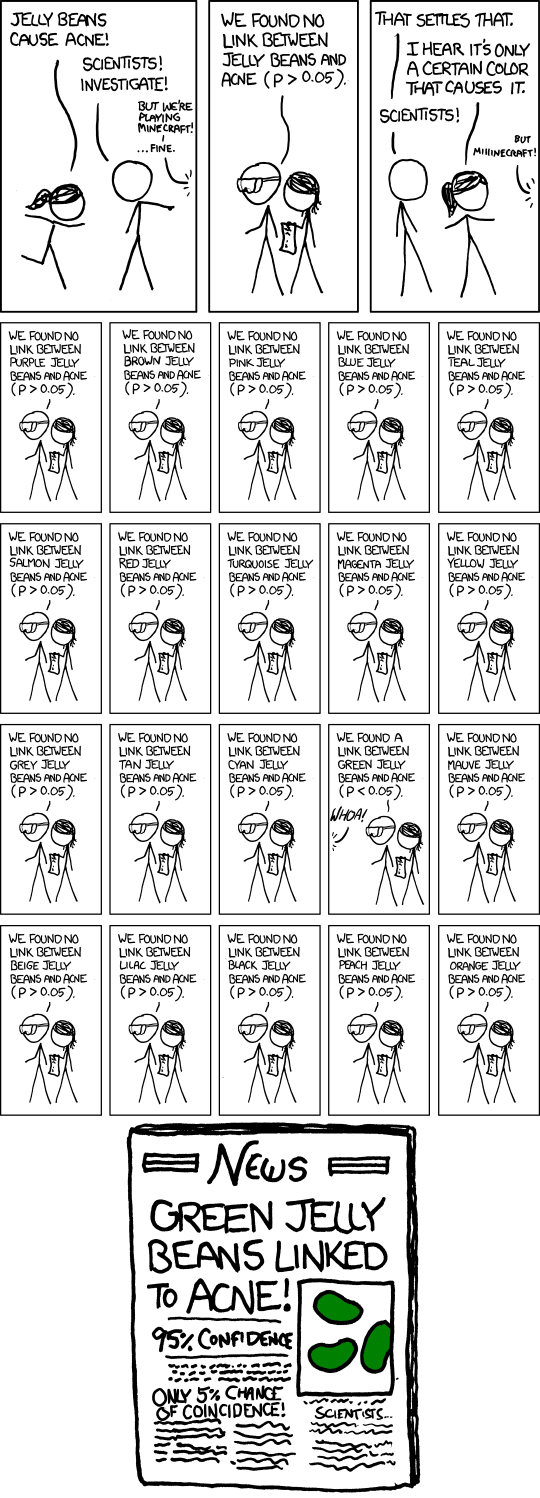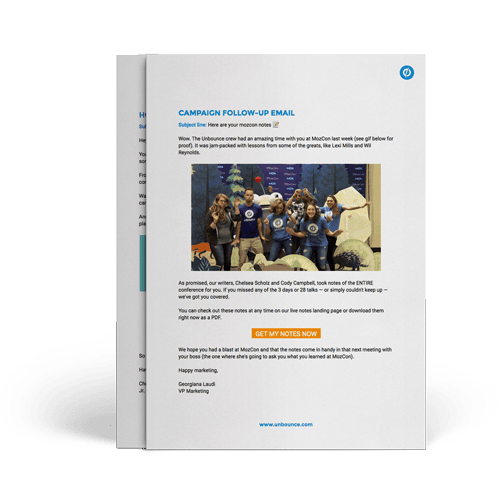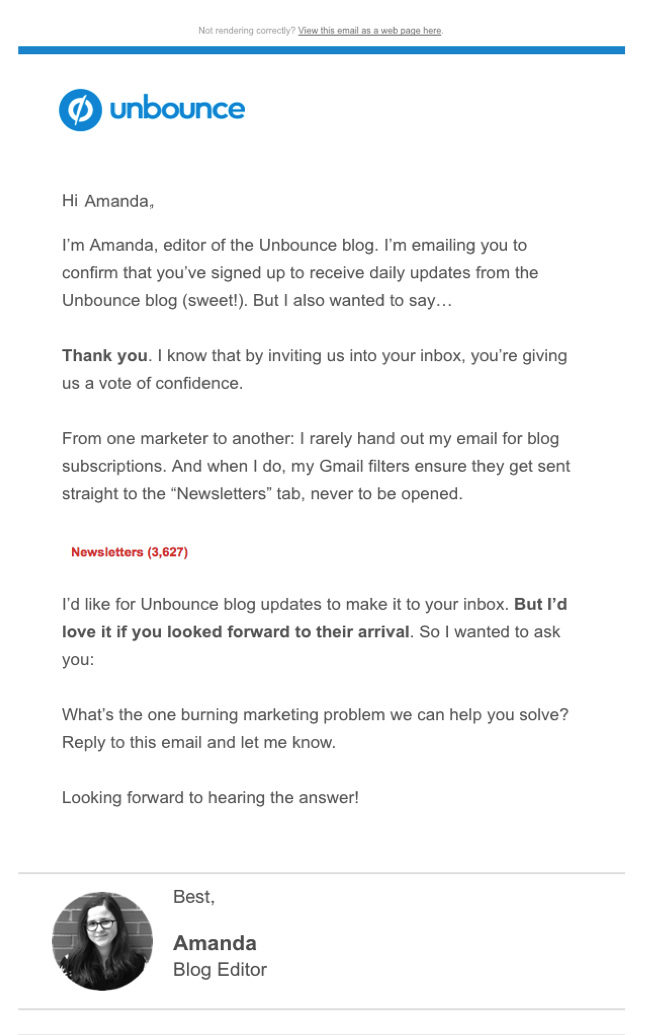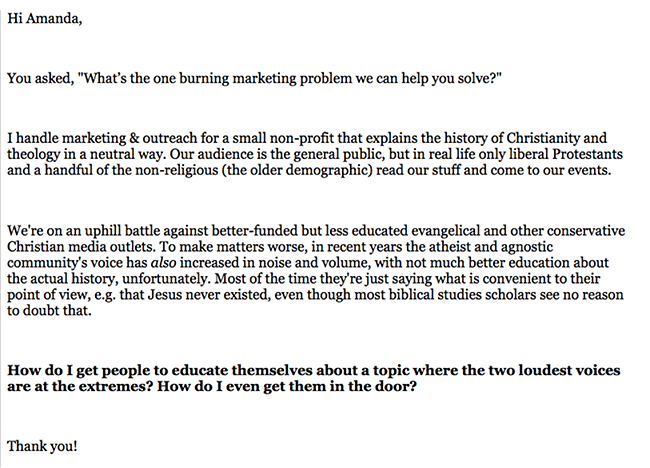Tuesday, October 18, 2016
50 B2B Marketing Influencers Speaking at #MPB2B 2016
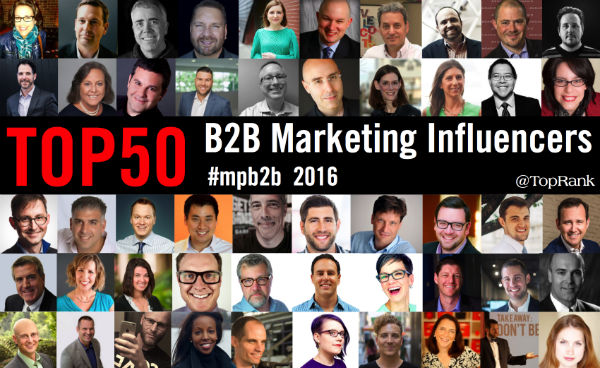
First of all, Happy 10th Birthday to Ann Handley and the MarketingProfs B2B Forum team!
Time flies when you're working hard, smart and with style – just like Sharon Hudson, Julie Pildner and their team have been for so many years to create a great experience for B2B Forum attendees.
There are a very small number of industry conferences that I look forward to attending year after year and the B2B Forum is at the top of that list. Many other B2B marketing practitioners and leaders that feel the same way and that's why the content is so good year after year. MarketingProfs has built something solid both in terms of the event and the community.
Being a part of that community is a special thing and it's a joy to connect, collaborate and participate with so many top notch marketers. My participation with this year's event has touched on several levels ranging from Ashley and Tom from my team helping with some event promotions and Ann's opening keynote to my presentation on activating B2B influencers and tools.
Speaking of influencers, below is a list of 50 speakers that are sure to influence your knowledge about B2B marketing this week at the B2B Forum in Boston.
As always, lists are great to be on, but can't include everyone. The ranking of this list is powered for the most part by Traackr, the influencer relationship management platform that we work with. The specific topic we sorted by was of course, “B2B marketing” and we just had to start it off with the queen bee of B2B, Ann Handley herself.
Ann Handley @marketingprofs
Chief Content Officer, MarketingProfs
Michael Brenner @brennermichael
CEO, Marketing Insider Group
Douglas Burdett @MarketingBook
Principal, Artillery Marketing
Lee Odden @leeodden
CEO, TopRank Marketing
Margaret Molloy @MargaretMolloy
Global CMO & Head of Business Development, Siegel+Gale
Matt Heinz @HeinzMarketing
President & Founder, Heinz Marketing
Doug Kessler @dougkessler
Creative Director & Co-Founder, Velocity Partners
Joe Pulizzi @joepulizzi
Founder, Content Marketing Institute
Jon Miller @jonmiller
CEO and Co-Founder, Engagio
Jason Miller @JasonMillerCA
Senior Manager – Global Content Marketing, LinkedIn
Carlos Hidalgo @cahidalgo
CEO & Principal, ANNUITAS
Ardath Albee @ardath421
CEO & B2B Marketing Strategist, Marketing Interactions
Jeffrey L. Cohen @jeffreylcohen
Director, Content Strategy at Oracle Marketing Cloud
Carlos Gil @CarlosGil83
Global Head of Social Media, BMC Software
Scott Brinker @chiefmartec
President, ion interactive, inc.
Mitch Joel @mitchjoel
President, Mirum Agency
Heidi Cohen @heidicohen
Chief Content Officer, Actionable Marketing Guide
Lauren Goldstein @laurenondemand
VP Strategy & Partnerships, Babcock & Jenkins
Christopher Penn @cspenn
Vice President of Marketing Technology, SHIFT Communications
Samantha Stone @samanthastone
Founder & CMO, The Marketing Advisory Network
Andy Crestodina @crestodina
Strategic Director, Orbit Media Studios, Inc.
Stephan Hovnanian @stephanhov
Content Solutions Architect, Bambu (by Sprout Social)
Jeremy Miller @StickyBranding
Brand Builder, Sticky Branding
Larry Kim @larrykim
Founder & CTO, WordStream, Inc
Steve Garfield @stevegarfield
Investor, Writer, Humorist
Jay Acunzo @jayacunzo
VP of Platform, NextView Ventures
Doug Bewsher @Dougino
CEO, Leadspace
Nick Westergaard @nickwestergaard
Chief Brand Strategist, Brand Driven Digital
Andrew Moravick @Amoravick
Senior Research Associate, Marketing Effectiveness & Strategy, Aberdeen Group
Scott Monty @scottmonty
CEO, Co-Managing Partner, Brain+Trust Partners
John Foley @johnfoleyjr
CEO/CMO, interlinkOne/Grow Socially
Andrea Vahl @andreavahl
Social Media Consultant and Speaker, Social Media Consultant
Amanda Nelson @amandalnelson
Senior Manager AppExchange Content & Community, Salesforce
Andrew Davis @drewdavishere
CEO, Monumental Shift
Tom Webster @webby2001
Vice President, Strategy and Marketing, Edison Research
Tamsen Webster @tamadear
Founder and CEO Strategic Speaking
Yoav Schwartz @yostar
Co-Founder, Uberflip
Paul Roetzer @paulroetzer
Founder and CEO, PR 20/20
Bob Ruffolo @BobRuffolo
Founder and CEO, IMPACT Branding & Design LLC
Jim Beretta @beretta
President, Customer Attraction Marketing Consulting
Dean Shaw @deanshaw
Global Chat Program Manager, SAS Institute
Marcus Sheridan @TheSalesLion
President, The Sales Lion
Oli Gardner @oligardner
Co-Founder, Unbounce
Sarah Lewis @sarahelizalewis
Assistant Professor, Harvard University & Author of The Rise
Michael Wesch @mwesch
University Distinguished Teaching Scholar/Associate Professor of Anthropology, Kansas State University
Erica McGillivray @emcgillivray
Senior Community Manager, Moz
Shane Snow @shanesnow
Chief Creative Officer and Co-Founder, Contently
Janet Driscoll-Miller @janetdmiller
President, Marketing Mojo
Chris Moody @cnmoody
Content Marketing Leader, GE Digital
Kristen Craft @thecrafty
Director of Business Development, Wistia
Thank you to all of the speakers who will be sharing their knowledge this week and especially to the team at MarketingProfs from Rob Zaleski to Ann Handley herself for creating such an amazing conference experience to look forward to. I know Ashley Zeckman, Caitlin Burgess and Leila De La Fuente from my team are looking forward to it!
There will be plenty of Tweeting from @toprank @azeckman @caitlinmburgess and @Leiladlf as well as liveblogging of the conference here on TopRank's Online Marketing Blog. Be sure to check back for updates.
![]()
Gain a competitive advantage by subscribing to the
TopRank® Online Marketing Newsletter.
© Online Marketing Blog - TopRank®, 2016. |
50 B2B Marketing Influencers Speaking at #MPB2B 2016 | http://www.toprankblog.com
The post 50 B2B Marketing Influencers Speaking at #MPB2B 2016 appeared first on Online Marketing Blog - TopRank®.
How to Run an A/B Test in Google Analytics
Designs don't always work out as intended.
The layout looks good. The color choices seem great. And the CTA balances clever and clear.
But…
It's not working. All of it. Some of it. You're not completely sure, but something's gotta give.
Despite everyone's best intentions, including all the hours of research and analyses, things don't always work out as planned.
That's where continuous testing comes in. Not a one-and-done or hail & pray attempt.
Even better, is that your testing efforts don't need to be complex and time consuming.
Here's how to set-up split test inside Google Analytics in just a few minutes.
What are Google Analytics Content Experiments?
Let's say your eCommerce shop sells Pug Greeting Cards. (That's a thing by the way.)
Obviously, these should sell themselves.
But let's just suspend disbelief for a moment and hypothesize that sales are low because you're having trouble getting people into these individual product pages in the first place.
Your homepage isn't a destination; it's a jumping off point.
Peeps come in, look around, and click somewhere else.
Many times that's your Product/Service pages. Often it's your About page.
Regardless, the goal is to get them down into a funnel or path as quickly as possible, (a) helping them find what they were looking for while also (b) getting them closer to triggering one of your conversion events.
The magic happens on a landing page, where these two things – a visitor's interest and your marketing objective – intertwine and become one in a beautiful symphony.
So let's test a few homepage variations to see which do the best job at directing new visitors into your best-selling products.
One has a video, the other doesn't. One is short and sweet, the other long and detailed. One has a GIF, the other doesn't.

New incoming traffic gets split across these page variations, allowing you to watch and compare the number of people completing your desired action until you can confidently declare a winner.
(It's probably going to be the one featuring this video.)
Running simple and straightforward split test like this is landing page optimization 101, where you identify specific page variables that result in the best results for your audience and multiply them across your site.
Google Analytics comes with a basic content experiments feature that will allow you to compare different page variations, split traffic to them accordingly, and get email updated about how results are trending and whether you're going to hit your defined objective or not.
But… they're technically not a straightforward A/B test. Here's why, and how that's actually a good thing.
Why Content Experiments Can Be Better than Traditional A/B Tests
Your typical A/B test selects a very specific page element, like the headline, and changes only that one tiny variable in new page variations.
The interwebs are full of articles where switching up button color resulted in a 37,596% CTR increase* because people like green buttons instead of blue ones. Duh.
(*That's a made up number.)
There's a few problems with your classic A/B test though.
First up, tiny changes often regress back to the mean. So while you might see a few small fluctuations when you first begin running a test, small changes usually only equal small results.

The second problem is that most A/B tests fail.
And if that weren't bad enough, the third issue is that you're going to need a TON of volume (specifically, 1,000 monthly conversions to start with and a test of at least 250 conversions) to determine whether or not those changes actually worked or not.
Google Analytics Content Experiments use an A/B/N model instead. Which is like a step in between one-variable-only A/B tests and coordinated-multiple-variable multivariate tests.
(After typing that last sentence, I realized only hardcore CRO geeks are going to care about this distinction. However it's still important to understand from a high level so you know what types of changes to make, try, or test).
You can create up to 10 different versions of a page, each with their own unique content or changes.
In other words, you can test bigger-picture stuff, like: “Does a positive or negative Pug value proposition result in more clicks?”
Generally these holistic changes can be more instructive, helping you figure out what messaging or page elements you can (and should) carry through to your other marketing materials like emails, social and more.
And the best part, is instead of requiring a sophisticated (read: time consuming) process to set up to make sure all of your variable changes are statistically significant, you can use Google Analytics Content Experiments to run faster, iterative changes and learn on-the-go.
Here's how to get started.
How to Setup Google Analytics Experiments
Setting up Content Experiments only takes a few seconds.
You will, however, have to set-up at least one or two page variations prior to logging in. That topic's beyond the scope here, so check out this and this to determine what you should be testing in the first place.
When you've got a few set-up and ready to go, login to Google Analytics and start here.
Step #1. Getting Started
Buried deep in the Behavior section of Google Analytics – you know, the one you ignore when toggling between Acquisition and Conversions – is the vague, yet innocuous sounding 'Experiments' label.
Chances are, you'll see a blank screen when you click on it that resembles:
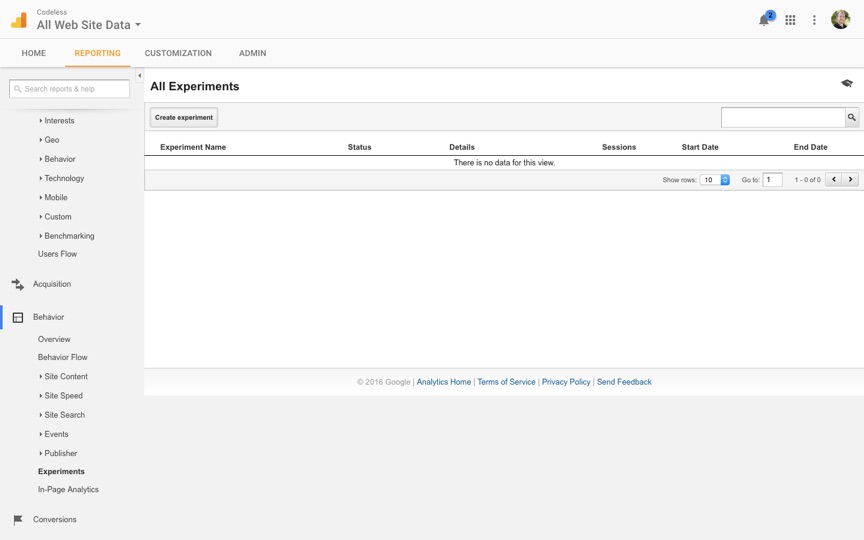
To create your first experiment, click the button that says Create Experiment on the top left of your window.
With me so far? Good.
Let's see what creating one looks like.
Step #2. Choose an Experiment
Ok now the fun starts.
Name your experiment, whatever.
And look down at selecting the Objective. Here's where you can set an identifiable outcome to track results against and determine a #winning variation.
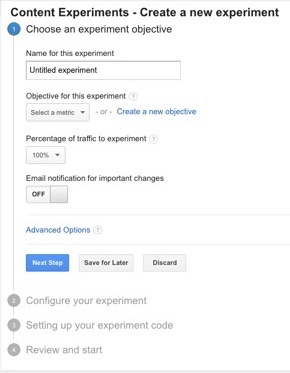
You have three options here. You can:
- Select an existing Goal (like opt-ins, purchases, etc.)
- Select a Site Usage metric (like bounce rate)
- Create a new objective or Goal (if you don't have one set-up already, but want to run a conversion-based experiment)
The selection depends completely on why you're running this test in the first place.
For example: most are surprised to find that their old blog posts often bring in the most traffic. The problem? Many times those old, outdated pages also have the highest bounce rates.
Navigate to: Behavior > Secondary Dimensions + Google/Organic > Top Pageviews > Bounce Rate.
Here's an example:

(Here are a few other actionable Google Analytics reports to spot similarly low hanging fruit when you're done setting up an experiment.)
Let's select Bounce Rate as the Objective for now, so we can make page changes to the layout, or increasing the volume and quantity of high quality visuals to get people to stick around longer.
After selecting your Objective, you can click on Advanced Options to pull up more granular settings for this test.
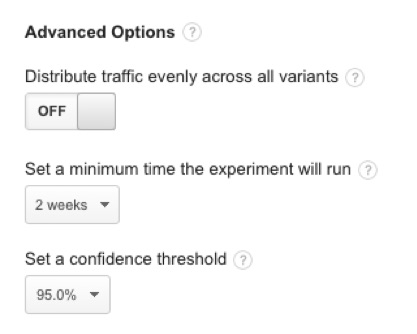
By default, these advanced options are off, and Google will “adjust traffic dynamically based on variation performance”.
However if enabled, your experiment will simply split traffic evenly across all the page variations you add, run the experiment for two weeks and shoot for a 95% statistical confidence level.
Those are all good places to start in most cases, however you might want to change the duration depending on how much traffic you get (i.e. you can get away with shorter tests if this page will see a ton of traffic, or you might need to extend it longer than two weeks if there's only a slow trickle).
So far so good!
Step #3. Configure Your Experiment
The next step is to simply add the URLs for all of the page variations you want to test.
Literally, just copy and paste:
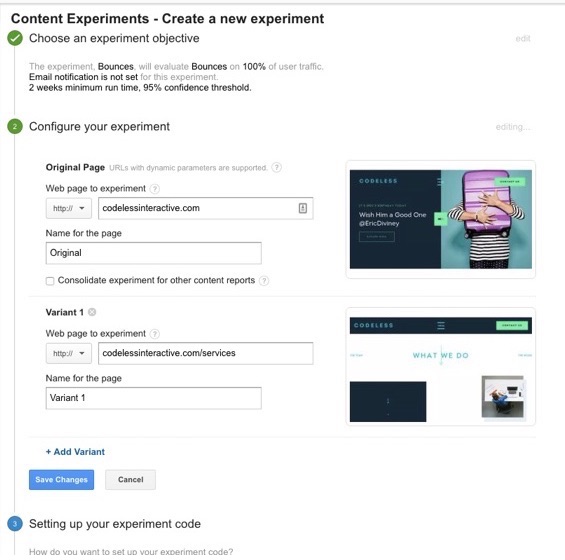
You can also give them helpful names to remember. Or not. It will simply number the variants for you.
Step #4. Adding Script Code to your Page
Now everyone's favorite part – editing your page's code!
The good news, is the first thing you see under this section is a helpful toggle button to just email all this crap code over to your favorite technical person.
If you'd like to get your hands dirty however, read on.

First up, double check all of the pages you plan on testing to make sure that your default Google Analytics tracking code is installed. If you're using a CMS, it should be, as it's usually added site-wide initially.
Next, highlight and copy the code provided.
You're going to need to look for the opening head tag in the Original variation (which should be located literally towards the top of your HTML document. Search for
to make it easy: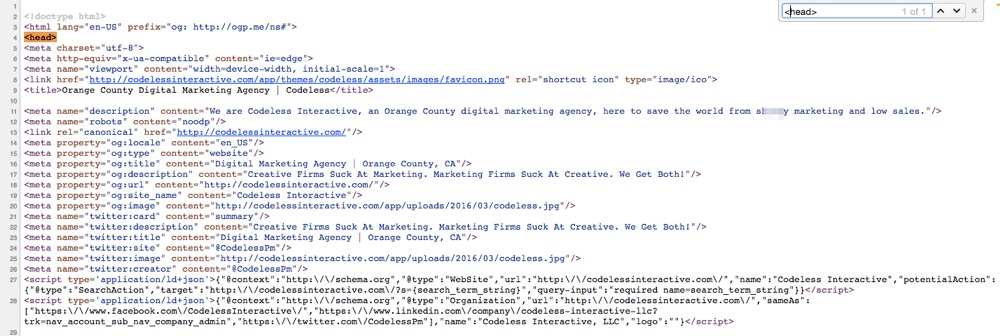
Once that's done, click Next Step back in Google Analytics to have them verify if everything looks A-OK.
Not sure if you did it right? Don't worry – they'll tell you.
For example, the first time I tried installing the code for this demo I accidentally placed it underneath the regular Google Analytics tracking code (which they so helpfully and clearly pointed out).
After double checking your work and fixing, you should see this:

And now you're ready to go!
See, that wasn't so bad now was it?!
Conclusion
Websites are never truly done and finished.
They need iteration; including constant analysis, new ideas, and changes to constantly increase results.
Many times, that means analyzing and test entire pages based on BIG (not small) changes like value propositions or layouts. These are the things that will deliver similarly big results.
Landing page optimization and split testing techniques can get extremely confident and require special tools that only CRO professionals can navigate.
However Google Analytics includes their own simple split testing option in Content Experiments.
Assuming you already have the new page variations created and you're comfortable editing your site's code, they literally only take a few seconds to get up-and-running.
And they can enable anyone in your organization to go from research to action by the end of the day.
About the Author: Brad Smith is a founding partner at Codeless Interactive, a digital agency specializing in creating personalized customer experiences. Brad's blog also features more marketing thoughts, opinions and the occasional insight.
Monday, October 17, 2016
Mastering the Art of Blogging: 6 Recipes to Help You Become A More Successful Content Creator
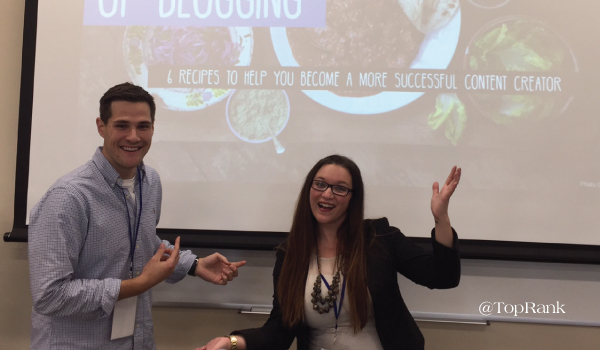
Last Saturday, Ashley Zeckman presented to a packed room of bloggers and shared a presentation titled: Mastering the Art of Blogging: 6 Recipes to Help You Become A More Successful Content Creator at the annual MN Blogger Conference.
The MN Blogger Conference offers a great opportunity for bloggers and content marketers to gather and learn insights on content strategy, search engine optimization, and social media. In her presentation, Ashley shared that unfortunately only 37% of companies have a documented content strategy (according to Content Marketing Institute and MarketingProfs) which presents an opportunity for content marketers to gain an advantage over competitors. Ashley was able to outline six recipes or strategies to gain your advantage. The six content marketing recipes include:
- Discovery Donuts
- Content Mission Canapés
- Best Answer Biscuits
- Less is More Lasagna
- Content Cheeseburger
- Influencer Ice Cream Sundae
Recipe 1: Discovery Donuts
The discovery donuts recipe focuses on understanding your audience. Ashley stated, “Today's consumers are overwhelmed with information and have become much more selective about which companies or brands they interact with.” To provide the best information for your audience, you need to build personas to target the right person within your audience. To build personas, ask your current customers directly with surveys, social polls, or calling them fairly continuously. Also, review your analytics to identify content types or key phrases from internal search that people are finding on your website. Analytics is a great tool that can help content marketers build a strategy that targets each personas. The last way to build a persona is to conduct keyword research to discover the “best answer” for their pain point.
Recipe 2: Content Mission Canapés
Ashley quoted Joe Pulizzi “To work, your [content] mission statement has to be all about the pain points of your readers.” To create a content mission statement that targets pain points you should include:
- Who you are.
- Who you're trying to reach.
- How you plan to reach them.
- What you want to accomplish.
Recipe 3: Best Answer Biscuits
One successful content marketing strategy is to provide the “best answer” for your audience's questions. Lee Odden was quoted, “Create signals of authority that position you as the best answer wherever your customers are searching.” The reason you want to be the best answer is because 50% of content gets 8 shares or less (BuzzSumo & Moz). The best answer will continue to be found via search and help your target audience. Key to a best answer strategy is creating resource rich content that ranks well in search engines. These pages should essential be the “best answer” for a particular topic.
Creating a consistent experience is also an important part of a “best answer” strategy since blogging today is actually a multi-channel approach. Everything from your blog posts to site content and social profiles need to create a consistent experience. Provide a consistent look and feel, along with messaging, to make your audience now that they are interacting with you.
Recipe 4: Less is More Lasagna
We are publishing so much content, that it is causing content overload. According to Ann Handley, “We don't need more content, we need better content.” The overall idea is to provide more quality content over quantity. Ashley states that why more content isn't better. She states, “When you try to pump out more content, the lowered quality can actually negatively impact the perception of your blog or brand.” Instead, focus on creating resource rich, high quality content.
To better reach prospective customers, identify key traits of your current ideal customers. Then develop profiles or personas to better target these identified audience members to focus on content impact. To create impact, make highly relevant content. Also, use contacts, tools and data to help determine relevance. Lastly, think about your distribution strategy.
Recipe 5: Content Cheeseburger
When it comes to content create evergreen content that can be slightly modified (or not) and be used again and again. Truth is, only a fraction of your audience saw it the first time, so why not share again. Also, use analytics to determine which posts resonate most with your audience. Always go back to your analytics to continue to identify what posts could be revised to meet changing audience needs. Another great content strategy would be to start a series to keep your readers coming back. Then you can point back to the previous posts in the series to breath new life into them.
Recipe 6: Influencer Ice Cream Sundae
Ashley shared that, “you can begin including influencer contributions into your blog content, without event having to perform outreach.” also utilize influencers to facilitate greater reach of your content, improve quality and some say influencer content can inspire more buyer engagement to leads and booked deals.
Ongoing influencer involvement can also lead to organic advocacy of your brand, products and services.If you curate or co-create, you can reach out to influencers and make it easy for them to share. Influencers are busy people so you want to remove as much friction as possible.
You can see Ashley's full presentation below on SlideShare:
![]()
Gain a competitive advantage by subscribing to the
TopRank® Online Marketing Newsletter.
© Online Marketing Blog - TopRank®, 2016. |
Mastering the Art of Blogging: 6 Recipes to Help You Become A More Successful Content Creator | http://www.toprankblog.com
The post Mastering the Art of Blogging: 6 Recipes to Help You Become A More Successful Content Creator appeared first on Online Marketing Blog - TopRank®.

